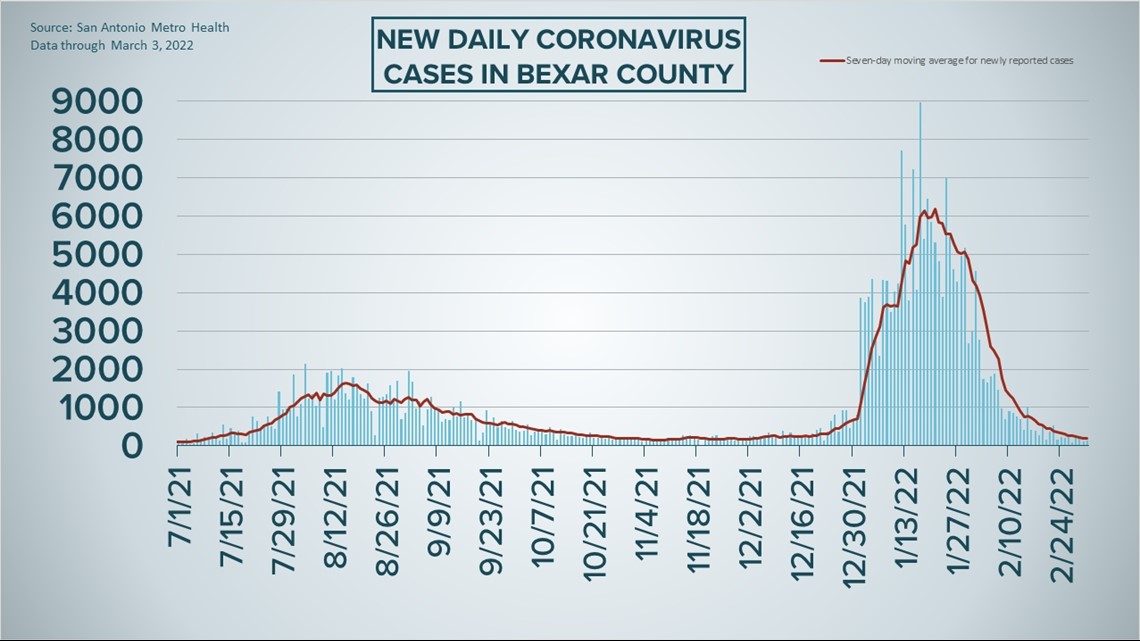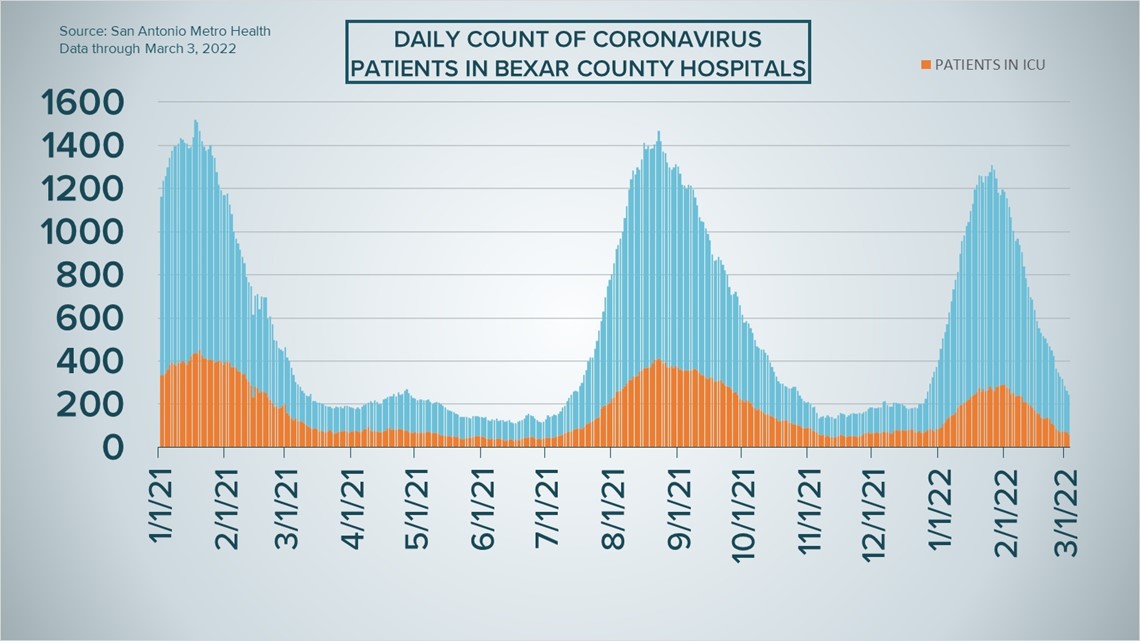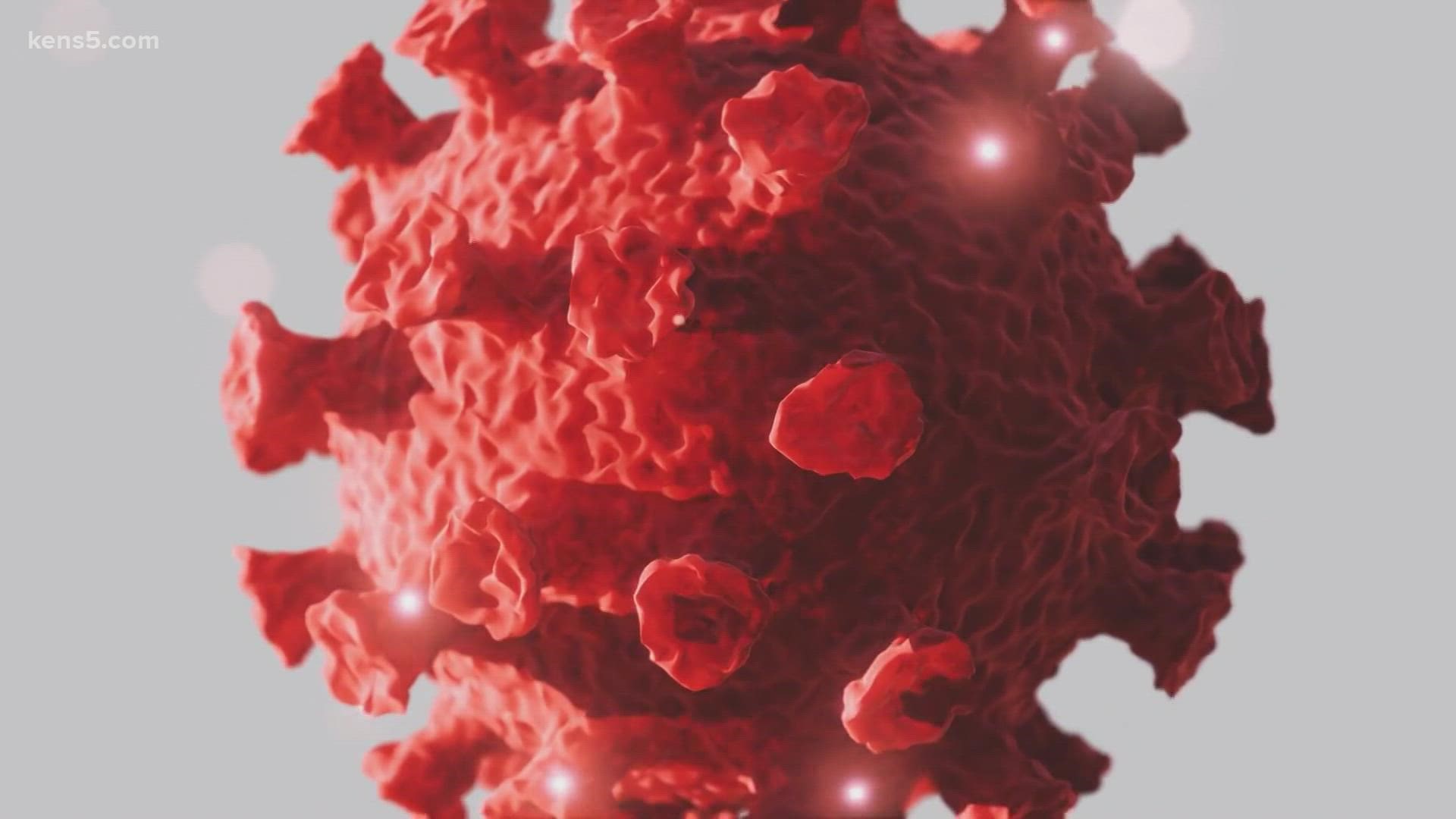SAN ANTONIO — As Bexar County's COVID-19 outlook continues to move in the right direction, the Centers for Disease Control say the community can now generally stop wearing masks, per its updated guidance released last week focusing on county-by-county hospital strain.
The CDC's new map, updated on Thursday, indicated the coronavirus now poses a medium threat to Bexar County hospitals, down from the "high" threshold previously. That means that, based on the agency's newest recommendations and metrics, face coverings are now most important for immunocompromised people and those who live with them.
The CDC says vaccines remain vital, as do booster shots, and quarantine recommendations remain in effect for those who test positive.
The development comes as local coronavirus numbers continue their weeks-long decline. Metro Health reported 132 new cases on Thursday, bringing the seven-day case average down once again to 189. Three new virus-related deaths were also reported, the fewest since Sunday.
Meanwhile, hospitalizations have gone down for 24 consecutive days. As of Thursday there are 242 Bexar County patients receiving treatment for COVID-19 symptoms in local facilities; the number is down by 43% over the last week and 78% over the last month. Of those 242 patients, 61 are in intensive care and 33 are using ventilators.
Nearly 524,000 San Antonio-area residents have been diagnosed with COVID-19, while at least 5,276 have died from virus complications.
How Bexar County is trending




Vaccine Progress in Bexar County
The following numbers are provided by San Antonio Metro Health. A full breakdown can be found here.
- 1.75 million eligible Bexar County residents have received at least one dose of the coronavirus vaccine as of Thursday, March 3.
- 1.427 million eligible Bexar County residents are fully vaccinated as of Thursday, March 3.
The CDC states that "when a high percentage of the community is immune to a disease (through vaccination and/or prior illness)," that community will have reached herd immunity, "making the spread of this disease from person to person unlikely."
The City of San Antonio breaks down the vaccination rates by zip code on Metro Health's Vaccination Statistics page.
Coronavirus in Texas
The total number of coronavirus cases in the state since the pandemic began grew by 3,584 on Wednesday, according to the Texas Department of State Health Services. That total includes 2,084 new confirmed cases and 1,499 new probable cases. No numbers for Thursday have been provided.
Wednesday's figures bring the total number of Texans diagnosed with COVID-19 to more than 6.557 million. More details can be found on this page.
An additional 206 Texans have died from virus complications, meanwhile, raising the statewide death toll to 83,899.
Coronavirus symptoms
The symptoms of coronavirus can be similar to the flu or a bad cold. Symptoms include fever or chills, cough, shortness of breath or difficulty breathing, fatigue, muscle or body aches, headache, new loss of taste or smell sore throat, congestion or runny nose, nausea or vomiting, and diarrhea, according to the Centers for Disease Control.
Most healthy people will have mild symptoms. A study of more than 72,000 patients by the Centers for Disease Control in China showed 80 percent of the cases there were mild.
But infections can cause pneumonia, severe acute respiratory syndrome, kidney failure, and even death, according to the World Health Organization. Older people with underlying health conditions are most at risk.
Experts determined there was consistent evidence these conditions increase a person's risk, regardless of age:
- Chronic kidney disease
- COPD (chronic obstructive pulmonary disease)
- Obesity (BMI of 30 or higher)
- Immunocompromised state (weakened immune system) from solid organ transplant
- Serious heart conditions, such as heart failure, coronary artery disease, or cardiomyopathies
- Sickle cell disease
- Type 2 diabetes
- The CDC believes symptoms may appear anywhere from two to 14 days after being exposed.
Human coronaviruses are usually spread...
- Between people who are in close contact with one another (within about 6 feet).
- Through respiratory droplets produced when an infected person coughs, sneezes or talks. These droplets can land in the mouths or noses of people who are nearby or possibly be inhaled into the lungs.
- Some recent studies have suggested that COVID-19 may be spread by people who are not showing symptoms.
Help stop the spread of coronavirus
- Stay home when you are sick.
- Eat and sleep separately from your family members
- Use different utensils and dishes
- Cover your cough or sneeze with your arm, not your hand.
- If you use a tissue, throw it in the trash.
Find a Testing Location
City officials recommend getting a COVID-19 test if you experience fever or chills, cough, shortness of breath or difficulty breathing, fatigue, muscle or body aches, headache, new loss of taste or smell, sore throat, congestion or runny nose, nausea or vomiting, or diarrhea.
Here's a Testing Sites Locator to help you find the testing location closest to you in San Antonio.
Latest Coronavirus Headlines
- Coronavirus Tracker: Bexar County's COVID-19 risk level falls to 'mild'
- FDA adds another COVID-19 test to 'do not use' list
- Hawaii to lift COVID-19 quarantine restrictions
- CDC still recommends masking indoors in San Antonio, despite relaxed guidance
- Why getting a COVID-19 booster should be a priority | Wear The Gown
- NFL suspends all COVID-19 protocols, cites improved health
- White House unveils new COVID preparedness plan to combat future variants
- Hong Kong reports record COVID-19 cases; movements may be restricted

